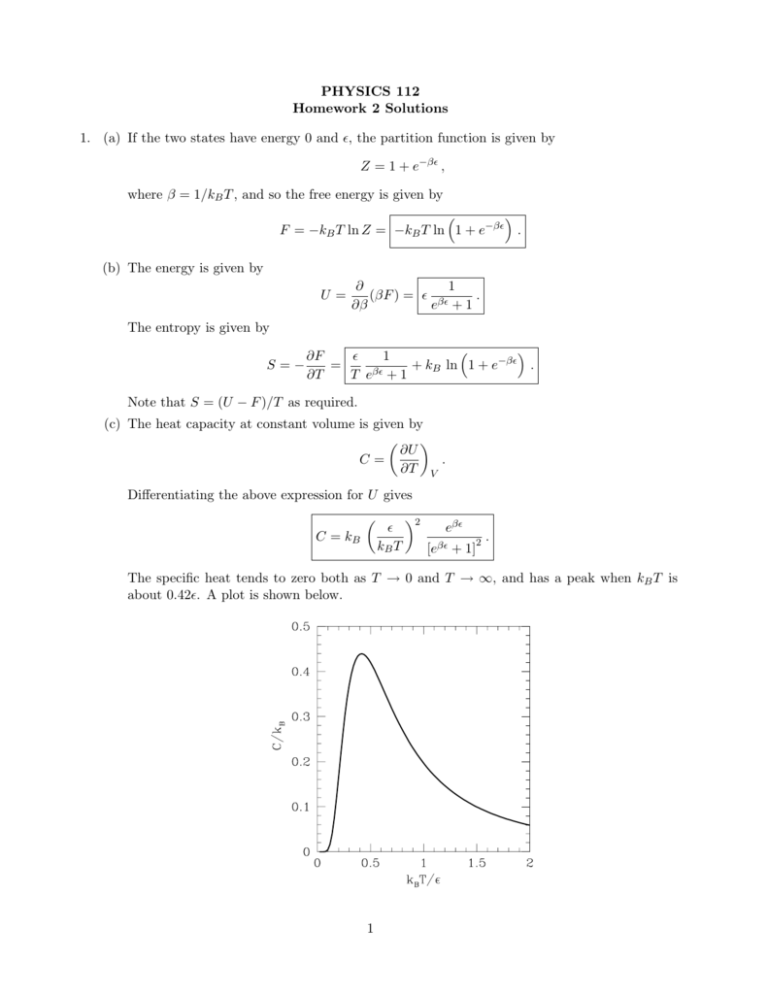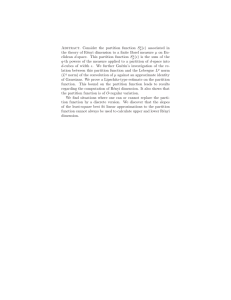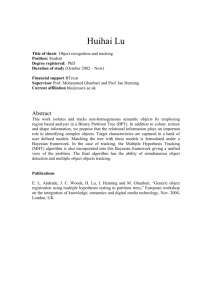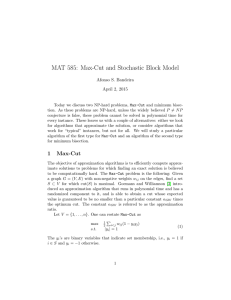PHYSICS 112 Homework 2 Solutions 1. (a) If the two states have
advertisement

PHYSICS 112 Homework 2 Solutions 1. (a) If the two states have energy 0 and ǫ, the partition function is given by Z = 1 + e−βǫ , where β = 1/kB T , and so the free energy is given by F = −kB T ln Z = −kB T ln 1 + e−βǫ . (b) The energy is given by U= 1 ∂ (βF ) = ǫ βǫ . ∂β e +1 The entropy is given by S=− ǫ 1 ∂F −βǫ = + k ln 1 + e . B ∂T T eβǫ + 1 Note that S = (U − F )/T as required. (c) The heat capacity at constant volume is given by ∂U . C= ∂T V Differentiating the above expression for U gives C = kB ǫ kB T 2 eβǫ 2 [eβǫ + 1] . The specific heat tends to zero both as T → 0 and T → ∞, and has a peak when kB T is about 0.42ǫ. A plot is shown below. 1 A peak like this in the specific heat due to a two-level system is called a “Schottky” specific heat. 2. (a) The energy levels are ±µB, and so the partition function for one spin, z, is given by z = eβµB + e−βµB = 2 cosh(βµB) . The probabilities of the +1 and −1 states are given by P1 = eβµB , z P−1 = e−βµB , z and hence the magnetization per spin is given by m = µ tanh(βµB) , (1) and the total magnetization is M = N µ tanh(βµB) . (b) For µB ≪ kB T we have, expanding the tanh in Eq. (1), m = µ2 B , kB T which is known as Curie’s law, as discussed in class. 3. For a simple harmonic oscillator the energy levels are ǫn = nh̄ω , in which, following the question we have set the zero of energy to be at ǫ0 . (More conventionally the energy levels are written ǫn = (n + 1/2)h̄ω.) (a) Hence the partition function is given by Z= ∞ X e−nβh̄ω . n=0 This is a geometric series whose sum is given by Z= 1 . 1 − e−βh̄ω Hence the free energy is given by h i F = −kB T ln Z = kB T ln 1 − e−βh̄ω . (b) The entropy is given by S=− h i h̄ω 1 ∂F −βh̄ω = − ln 1 − e . ∂T T eβh̄ω − 1 2 4. We have 1 X En e−βEn , Z n U ≡ hEi = and hE 2 i = where (2) 1 X 2 −βEn , E e Z n n X Z= e−βEn . n Differentiating Eq. (2) with respect to T gives (remember Z also depends on T ) " ! # X ∂U 1 1 X 1 X 2 −βEn = E e − 2 En e−βEn Em e−βEm ∂T kB T 2 Z n n Z n m 1 = hE 2 i − hEi2 kB T 2 1 2 (E − hEi) . = kB T 2 (3) Note: This shows that the mean square fluctuation in the energy is proportional to ∂U/∂T , the heat capacity (also called the specific heat). Since U , and hence the specific heat, is extensive the root mean square fluctuation √ in the energy (which is a typical deviation√of the energy from its mean) is proportional to N . We have seen several specific examples of N fluctuations in the course, and here we see that the fluctuations in the energy vary quite generally in this way. 5. The energy levels of a diatomic molecule coming from its rotation motion are given by ǫ(j) = j(j + 1)ǫ0 j = 0, 1, 2, · · · , and their degeneracy (multiplicity) is 2j + 1. (a) Hence the partition function is given by Z= ∞ X (2j + 1)e−βj(j+1)ǫ0 , j=0 (note the inclusion of the degeneracy factor 2j + 1). While this cannot be evaluated exactly in closed form, it can be evaluated for very low T and very high T . (b) We first consider very high T , for which the Boltzmann factor e−βj(j+1)ǫ0 doesn’t change much from one j to the next, and so we can replace the sum by an integral: Z≃ Z 0 ∞ (2j + 1)e−βj(j+1)ǫ0 dj = − 1 1 h −βj(j+1)ǫ0 i∞ = e . βǫ0 βǫ0 0 (4) (c) In the low T limit we just consider the first two terms (the rest will be negligible) so Z ≃ 1 + 3e−β2ǫ0 . 3 (5) (d) Now U = −(∂/∂β) ln Z and applying this to Eq. (4) gives U= ∂ 1 ln(βǫ0 ) = = kB T . ∂β β The specific heat is ∂U = kB . ∂T We see that the specific heat tends to a constant at high temperature. At low temperature, we obtain from Eq. (5) C= U =− h i 6ǫ0 e−2βǫ0 ∂ ln 1 + 3e−2βǫ0 = ≃ 6ǫ0 e−2βǫ0 . ∂β 1 + 3e−2βǫ0 The specific heat is given by C= ∂U = 12kB ∂T ǫ0 kB T 2 e−2βǫ0 . Both the energy and specific heat vanish exponentially for T → 0. (e) Sketching the energy and specific heat turns out to be a bit tricky. For example you may imagine that the specific heat increases monotonically from 0 to kB as T increases from 0 to ∞, but it actually overshoots, with a peak value of about 1.1kB at kB T ≃ 0.81ǫ0 . Since this is not obvious, you will get full credit for a monotonically increasing curve. Also, the energy actually tends to kB T − ǫ0 /3 at high T (the constant was not given at our level of approximation) and so it actually lies parallel to the line U = kB T at high T but not on it. However, if you drew the curve equaling kB T at high T you will get full credit. The figure below is the correct result obtained numerically. The solid line is for U and the dashed line for C. The dotted lines indicate the limits of C/kB and U/ǫ0 at high temperature (1 and kB T /ǫ0 − 1/3 respectively). 4 6. (a) The states of the system are: 0 links unzipped, 1 link unzipped, 2 links unzipped etc. Since the unzipping has to start from the left, there is only one state with a given number of links unzipped. Hence the partition function is given by Z = 1 + e−βǫ + e−2βǫ + · · · + e−N βǫ , and the standard result for the sum of a geometric series gives Z= 1 − e−(N +1)βǫ . 1 − e−βǫ (b) At low temperature, βǫ ≫ 1, we only need consider the two lowest energy levels, that with 0 open links and that with 1 open link. In this limit the partition function becomes Z ≃ 1 + e−βǫ , and the average number of open links is 0. e−βǫ e−βǫ 1 + 1. = ≃ e−βǫ . Z Z 1 + e−βǫ 7. We consider two independent systems “1” and “2”. Independent means that the allowed values of the energy of system 1, for example, are independent of the value of the energy of system 2. Hence if we denote the energy of a particular state of system 1 by E1,i and that of system two by E2,j , then the sum over all states of the whole system is obtained by summing independently over i and j. Hence the partition function of the combined system is given by XX X X Ztot = exp [−β(E1,i + E2,j )] = exp(−βE1,i ) exp(−βE2,j ) = Z1 Z2 . i j i j Consequently the total free energy Ftot = −kB T ln Ztot is given by Ftot = −kB T ln Z1 Z2 = −kB T (ln Z1 + ln Z2 ) = F1 + F2 , i.e. it is the sum of the free energies of the two independent systems. Since the free energy, like the energy, is an extensive quantity, this is expected. 5











